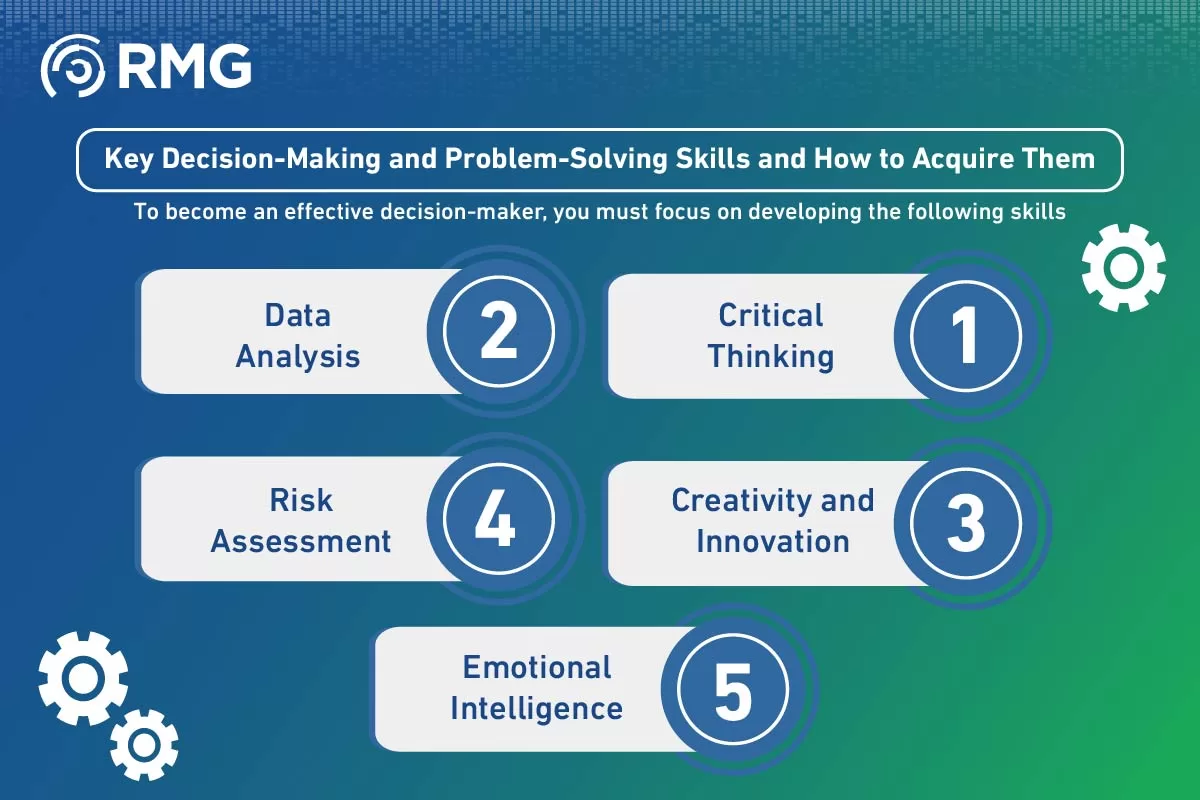Blog Body
Discover the secrets to effective decision-making! This comprehensive guide offers practical steps and essential skills for smart problem-solving and avoiding common mistakes. Elevate your leadership and personal abilities now.
At every moment of our lives, we stand at a crossroads, facing choices that range from simple to complex, from personal to professional. This is where decision-making emerges as a fundamental process that shapes the course of our lives and the future of our organizations. The ability to arrive at sound and well-considered choices is not merely an innate talent, but a scientific and artistic skill that can be learned and refined. In this comprehensive article, we will delve into the depths of this pivotal concept, explore its systematic steps, highlight the most important skills needed to master it, and uncover the methods to avoid to ensure the best possible outcomes.
The Concept of Decision-Making
This concept is defined as the cognitive mental process by which an individual or group selects one course of action from a set of available alternatives. This process is not limited to mere selection; it includes a deep analysis of the situation, a precise evaluation of options, and a foresight into the potential outcomes of each alternative. It is the cornerstone of successful management and effective leadership, as the quality of decisions made directly reflects the level of performance and achieved success.
Definition of Decision-Making
More specifically, this process can be defined as the final outcome of a mental process aimed at solving a problem or exploiting an opportunity. It is a conscious and intentional choice followed by practical action. A decision represents a commitment to allocate resources (whether time, money, or effort) in a specific direction, which makes it of paramount importance in both personal and institutional contexts.
What is the Definition of Decision-Making (plural)?
When we speak in the plural, we refer to the continuous and sequential set of processes that occur within an organization or in an individual’s life. No decision operates in a vacuum; every choice is part of an interconnected series of decisions that influence and are influenced by each other. Therefore, managing the decision-making process requires a strategic vision and the ability to understand the bigger picture and the short-term and long-term implications of each choice.
Decision-Making and Problem-Solving Skills
Mastering the art of decision-making is closely linked to possessing a set of essential skills. Decision-making and problem-solving skills are the tools that enable leaders and managers to navigate complex work environments with confidence and efficiency. These skills are not separate; rather, they work together in perfect harmony to achieve the best results.
Key Decision-Making and Problem-Solving Skills and How to Acquire Them
To become an effective decision-maker, you must focus on developing the following skills:
- Critical Thinking: The ability to objectively analyze information, identify assumptions, evaluate arguments, and draw logical conclusions.
- How to acquire it: Practice asking “why” and “how” questions. Analyze news articles or case studies from multiple perspectives.
- Data Analysis: The ability to collect and interpret quantitative and qualitative data to formulate evidence-based options rather than relying solely on intuition.
- How to acquire it: Learn the basics of software like Excel or data analysis tools. Take data analysis courses to understand how to read numbers and extract insights from them.
- Creativity and Innovation: The ability to generate unconventional solutions and alternatives to complex problems.
- How to acquire it: Practice brainstorming sessions, read in diverse fields outside your specialization, and don’t be afraid to try new approaches.
- Risk Assessment: The ability to identify potential risks associated with each option and evaluate their likelihood and impact.
- How to acquire it: Use tools like a Risk Matrix or SWOT analysis to categorize alternatives based on their risk level.
- Emotional Intelligence: Understanding and managing your emotions and the emotions of others to arrive at balanced and unbiased choices.
- How to acquire it: Practice self-awareness, listen attentively to others, and try to understand their perspectives before judging them.
Steps of Decision-Making
To transform this vital process from a random path into a scientific methodology, a series of organized steps can be followed to ensure coverage of all important aspects.
- Accurately Define the Problem or Objective: The first and most important step is to understand the essence of the situation. What decision needs to be made? What problem are we trying to solve?
- Gather Information and Data: Seek out all relevant information on the subject. Consult experts, collect data, and review past experiences.
- Identify Available Alternatives: Generate a comprehensive list of all possible options and solutions. At this stage, be creative and don’t rule out any idea.
- Evaluate Alternatives: Analyze each alternative based on pre-defined criteria, such as cost, time, required resources, risks, and expected benefits.
- Choose the Optimal Alternative: Based on the previous evaluation, select the alternative that achieves the best balance between objectives, resources, and risks.
- Implement the Decision: Develop a clear action plan to execute the chosen option. Define responsibilities, timelines, and necessary resources.
- Review and Evaluate: After implementing the decision, monitor the results and assess its success in achieving the desired objectives. Learn from the experience to improve your future decisions.
Understand the Steps of Decision-Making (plural)
When we talk about the steps of decision-making in an institutional context, the process often includes additional dimensions related to communication and participation. The previous steps remain the core, but the following are added:
- Involve Stakeholders: Identify the parties who will be affected by the decision and involve them in the process to ensure their acceptance and support.
- Transparent Communication: Explain the reasons for choosing a particular course of action to the team or organization to foster trust and commitment.
- Build Consensus: In collective decisions, it is important to work on building consensus among team members to ensure smooth implementation.
Factors That Help in Deliberate and Unhurried Decision-Making
Haste is the first enemy of sound decisions. To ensure thoughtful and well-considered decisions, the following factors can be utilized:
- Set Realistic Deadlines: Give yourself and your team enough time to gather and analyze information.
- Take a Break: If you feel overwhelmed or stressed, step away from the problem for a while. Better solutions often come with a clear mind.
- The “Sleep on It” Principle: For major choices, give yourself a full night to think about them. This allows your subconscious mind to process information.
- Consult a Counselor or Mentor: Getting an outside perspective from someone you trust can reveal aspects you hadn’t considered.
Ineffective Decision-Making Methods
To avoid falling into traps, it is essential to be aware of common mistakes. To avoid falling into the trap of bad decisions, you must be wary of the following methods:
- Analysis Paralysis: Over-gathering and analyzing information to the point where it hinders reaching any decision.
- Confirmation Bias: Seeking information that confirms your preconceived beliefs and ignoring information that contradicts them.
- Groupthink: The tendency to conform to the majority opinion in a group to avoid conflict, even if the decision is wrong.
- Over-reliance on Intuition: Making important decisions based solely on gut feeling without supporting them with data and evidence.
Continuing from the previous point, harmful methods also include:
- Procrastination: Delaying making decisions out of fear of taking responsibility, which can lead to missed opportunities or worsening problems.
- Emotional Decisions: Allowing emotions like anger, fear, or excessive enthusiasm to control the decision-making process, leading to irrational outcomes.
- Sunk Cost Fallacy: Continuing to invest resources in a failed course of action simply because you have already invested so much in it.
Decision Center
In organizational structures, the term “decision center” refers to the administrative level or entity responsible for making strategic decisions. This center can be senior management (C-Suite), the board of directors, or a specialized executive committee. Clearly defining the decision center prevents chaos and ensures that decisions are made by individuals who possess the necessary authority and knowledge.
Representation of Decision-Making in a Flowchart is in the Shape of a Rectangle
Here, a precise technical point needs clarification. While this statement may be common, it is technically inaccurate in standard practice. In flowcharts, processes or actions are represented by a rectangle. However, the choice or decision point itself, which involves a question with two or more answers (such as “yes/no”), is represented by a diamond. This geometric shape allows the path to branch based on the outcome of the decision, which distinguishes it from the execution process represented by a rectangle.
Effective Ways to Develop Decision-Making Skills in Life and Work
Continuous development is the key to excellence. Here are some effective ways:
- Deliberate Practice: Start with small, low-risk decisions, and analyze their results.
- Seek Feedback: Ask your colleagues or manager for their opinion on your decision-making approach.
- Learn from Mistakes: Do not view bad choices as failures, but as opportunities to learn. Analyze where you went wrong and how you can avoid it in the future.
- Use Models and Frameworks: Practice using tools such as SWOT analysis, Eisenhower Matrix, or cost-benefit analysis.
How to Develop Your Decision-Making Skills and Solve Problems Smartly?
To move from just a decision-maker to a smart decision-maker, you need to integrate intelligence with methodology:
- Broaden Your Knowledge Horizon: Read extensively in diverse fields. The more you know, the better your ability to connect the dots and see the big picture.
- Challenge Your Assumptions: Before every decision, ask yourself: “What assumptions am I basing my choice on? What if they are wrong?”
- Consider Second and Third-Order Consequences: Don’t just think about the direct impact of your decision, but also its indirect and cascading effects.
Practical Steps to Develop Decision-Making and Problem-Solving Skills
To turn theory into reality, follow these practical steps:
- Keep a Decision Log: Document your important decisions, the reasons behind them, and the outcomes.
- Join Workshops or Training Courses: Invest in your professional development through specialized programs in leadership and decision-making.
- Find a Mentor: Learn from the experience of someone wiser and more experienced than you.
- Role-Playing and Simulations: Participate in simulation exercises that require you to make quick decisions under pressure.
Renad Al Majd: Your Strategic Partner for Empowering Leaders and Making Sound Decisions
In the rapidly changing business world, decision-making is no longer just a management process; it has become a crucial competitive advantage. Renad Al Majd (RMG) deeply understands this reality and prides itself on being the strategic partner that enables organizations and government entities to build an institutional culture based on well-considered and data-driven decisions. We do not offer ready-made solutions; instead, we work alongside our clients to understand their unique challenges and design specialized training and consulting programs aimed at refining the decision-making skills of leaders and teams alike. Through interactive workshops, leadership consulting sessions, and the application of the latest global methodologies, we help your organization transform challenges into opportunities and elevate this pivotal process from a mere reaction to a proactive vision that shapes the future.
Build Your Organization’s Future with Renad Al Majd’s Expertise in Decision-Making
We invite all leading organizations, ambitious government entities, and companies striving for leadership in their sectors to a strategic partnership with Renad Al Majd. Investing in developing your team’s ability to make effective decisions and solve problems is a direct investment in your organization’s future, enhancing operational efficiency, reducing risks, and opening new horizons for innovation and growth. Contact us today to explore how our customized programs can contribute to building leaders capable of navigating the toughest circumstances with confidence and wisdom, and achieving the sustainable excellence you aspire to. Renad Al Majd, where expertise transforms into decisions that shape success.
Conclusion on Decision-Making
In conclusion, decision-making is both an art and a science. It is the engine that propels us forward and the compass that guides our path in a sea of possibilities. By deeply understanding its concept, following its systematic steps, developing the necessary skills, and avoiding common mistakes, any individual or organization can significantly improve the quality of their decisions. Always remember that every decision, no matter how small, is a building block in the edifice of your future. Let your decisions be thoughtful, wise, and courageous.















